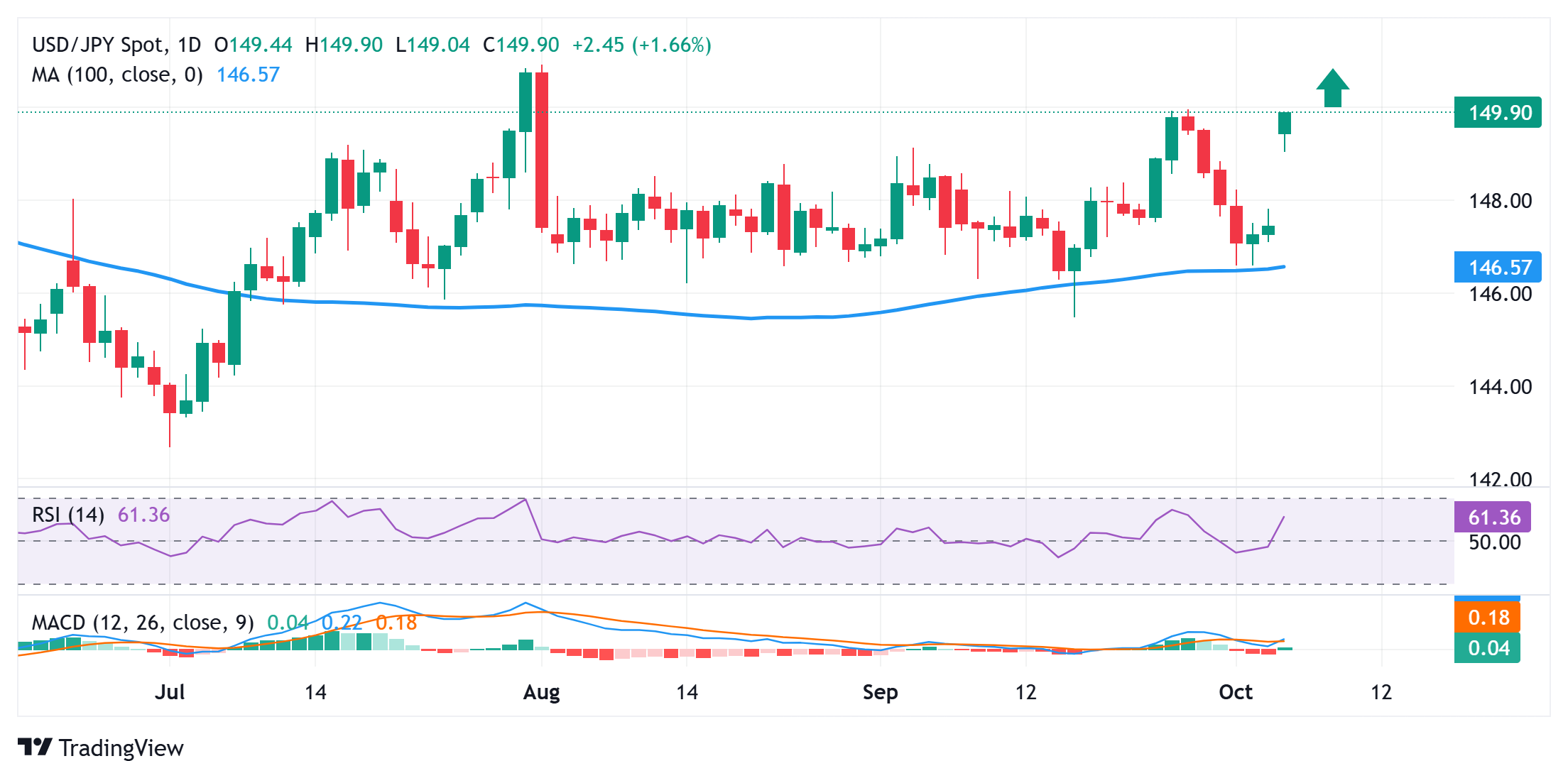Japanese Yen sinks as Takaichi's win sparks fiscal easing bets, tempers BoJ rate hike bets
- The Japanese Yen weakened sharply in reaction to Sanae Takaichi’s election as the leader of Japan's ruling LDP.
- Japan's Nikkei 225 rallies to a fresh record high amid stimulus hopes and further weighs on the safe-haven JPY.
- Fed rate cut bets and the US government shutdown might cap any further gains for the USD and the USD/JPY pair.
The Japanese Yen (JPY) slumps across the board at the start of a new week in reaction to the outcome of Japan's ruling Liberal Democratic Party (LDP) leadership election, which positions Sanae Takaichi to become the first female Prime Minister. Takaichi is viewed as fiscally dovish and is expected to oppose any further monetary tightening by the Bank of Japan (BoJ). This, along with the upbeat market mood, prompts aggressive selling around the safe-haven JPY during the Asian session on Monday.
Meanwhile, a sharp weakening in the JPY provides a goodish lift to the US Dollar (USD) and pushes the USD/JPY pair closer to the 150.00 psychological mark, or the highest level since August, touched earlier this month. The upside for the USD, however, seems limited in the wake of bets that the US Federal Reserve (Fed) will cut rates two more times this year and concerns that a prolonged US government shutdown could impact the US economic performance. This, in turn, might cap the currency pair.
Japanese Yen slumps as Takaichi's victory spurs bets of fiscal easing and delayed BoJ rate hikes
- Sanae Takaichi was elected as the leader of the Liberal Democratic Party (LDP) in a run-off election held on Saturday and is now expected to be confirmed as Japan's first female Prime Minister during a parliamentary session in mid-October. Takaichi stood out in the race as the only proponent of big spending and loose monetary policy.
- Expectations for more expansionary economic policies could complicate the Bank of Japan's task and also seem to have raised the chances that the central bank will avoid raising interest rates this month. The optimism lifts Japan's Nikkei 225 to a fresh record high and weighs heavily on the Japanese Yen during the Asian session on Monday.
- Meanwhile, BoJ Governor Kazuo Ueda reiterated last week that the central bank will raise interest rates if the economy and prices move in line with forecasts. Moreover, markets are fully pricing in another rate increase by the BoJ early next year, which might continue to offer some support to the JPY and help limit deeper losses.
- The BoJ's hawkish stance marks a significant divergence in comparison to rising bets that the US Federal Reserve (Fed) will lower borrowing costs in October and in December. Adding to this, concerns about the economic impact of a US government shutdown might keep a lid on any further USD appreciation and cap the USD/JPY pair.
- Important US macro releases scheduled at the start of a new month have been delayed due to the government closure, leaving the USD at the mercy of speeches from influential FOMC members. This, along with the broader risk sentiment, could drive the USD/JPY pair ahead of Japan's Household Spending data due for release on Tuesday.
USD/JPY could accelerate the positive momentum above the September swing high, around 150.00

From a technical perspective, last week's bounce from the 100-day Simple Moving Average (SMA) and a subsequent move up beyond the 150.00 round figure will be seen as a fresh trigger for the USD/JPY bulls. Given that oscillators on the daily chart have again started gaining positive traction, spot prices might then aim to test the August monthly swing high, around the 151.00 neighborhood, with some intermediate resistance near the 150.65-150.70 region.
On the flip side, any corrective slide below the 149.40 immediate support could be seen as a buying opportunity and remain limited near the Asian session low, around the 149.00 mark. A convincing break below the latter could drag the USD/JPY pair to the next relevant support near the 148.35 region en route to the 148.00 round figure and the 147.80 zone, which, if broken, might shift the near-term bias in favor of bearish traders.
Japanese Yen FAQs
The Japanese Yen (JPY) is one of the world’s most traded currencies. Its value is broadly determined by the performance of the Japanese economy, but more specifically by the Bank of Japan’s policy, the differential between Japanese and US bond yields, or risk sentiment among traders, among other factors.
One of the Bank of Japan’s mandates is currency control, so its moves are key for the Yen. The BoJ has directly intervened in currency markets sometimes, generally to lower the value of the Yen, although it refrains from doing it often due to political concerns of its main trading partners. The BoJ ultra-loose monetary policy between 2013 and 2024 caused the Yen to depreciate against its main currency peers due to an increasing policy divergence between the Bank of Japan and other main central banks. More recently, the gradually unwinding of this ultra-loose policy has given some support to the Yen.
Over the last decade, the BoJ’s stance of sticking to ultra-loose monetary policy has led to a widening policy divergence with other central banks, particularly with the US Federal Reserve. This supported a widening of the differential between the 10-year US and Japanese bonds, which favored the US Dollar against the Japanese Yen. The BoJ decision in 2024 to gradually abandon the ultra-loose policy, coupled with interest-rate cuts in other major central banks, is narrowing this differential.
The Japanese Yen is often seen as a safe-haven investment. This means that in times of market stress, investors are more likely to put their money in the Japanese currency due to its supposed reliability and stability. Turbulent times are likely to strengthen the Yen’s value against other currencies seen as more risky to invest in.

